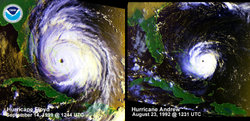Earth:Hurricane Severity Index
The Hurricane Severity Index (or HSI) measures the strength and destructive capability of a storm based on its size and wind intensity.[1] The HSI attempts to demonstrate that two hurricanes of similar intensity may have different destructive capability due to variances in size, and furthermore that a less intense, but very large hurricane, may in fact be more destructive than a smaller, more intense hurricane. It is very similar to the Chicago Mercantile Exchange Hurricane Index, which also factors both size and intensity of a hurricane.[2] HSI was developed by a private company program in competition with the National Weather Service's accumulated cyclone energy index.
Components of the index
The Hurricane Severity Index is a 50-point scale, with wind intensity and size contributing equally.
Determining size points
| Wind Radii | Size Point Range |
|---|---|
| 35 kn | 1–3 |
| 50 kn | 1–4 |
| 65 kn | 1–8 |
| 87 kn | 1–10 |
See also
- Beaufort scale
- Fujita scale
- Outline of tropical cyclones
- Severe weather terminology (disambiguation)
References
- ↑ Chris Hebert (ImpactWeather Inc.), B. Weinzapfel, and M. Chambers (1 May 2008). "The Hurricane Severity Index – A destructive potential rating system for tropical cyclones". 28th Conference on Hurricanes and Tropical Meteorology. American Meteorological Society. http://ams.confex.com/ams/28Hurricanes/techprogram/paper_139371.htm. Retrieved 2008-12-28.
- ↑ "CME Hurricane Index Futures and Options". CME Group. https://www.cmegroup.com/trading/weather/files/WT106_NEWHurricaneFC.pdf.
- ↑ "ImpactWeather". http://katrina.impactweather.com/hsi/hsi.pdf.
External links
- Hebert, Chris, Bob Weinzapfel and Mark Chambers. “Hurricane Severity Index: A New Way of Estimating a Tropical Cyclone’s Destructive Potential”. 29th Conference on Hurricanes and Tropical Meteorology, 10–14 May 2010, Tucson, Arizona. American Meteorological Society. http://ams.confex.com/ams/29Hurricanes/techprogram/paper_168529.htm
 |


